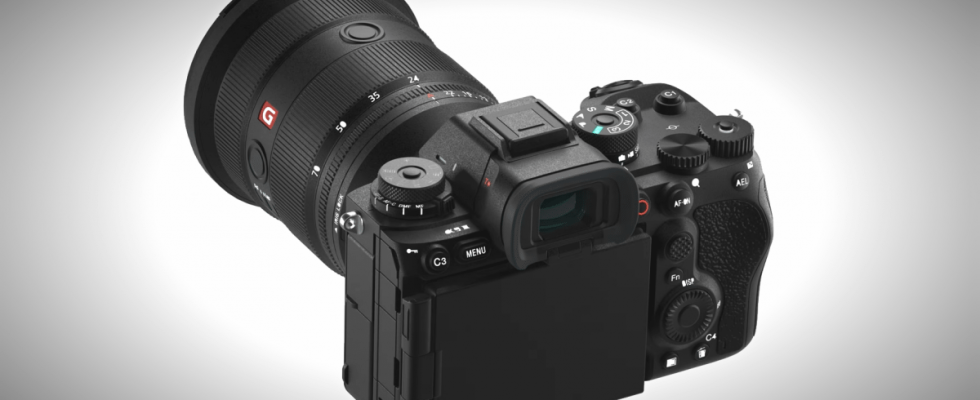Sony has introduced the Alpha 9 III, the successor to its 9 series professional camera, which was last updated in 2019. The mirrorless device is scheduled to come onto the market at the beginning of 2024 and is primarily designed for sports and reportage photography. What matters most is speed, not the highest resolution. Therefore, the full-format sensor remains at 24 megapixels, like other cameras in this category.
Advertisement
However, according to Sony, the component called Exmor RS is the first full-format CMOS sensor to work with a global shutter. This means that the entire image content is read out in one step and not line by line. As with the top models from other manufacturers, there is no longer a mechanical lock. When the lens is removed, a plastic flap protects the sensor.

No more rolling shutter
The global shutter not only eliminates the rolling shutter effect, which is very restrictive when filming, but also eliminates distortion during fast panning. Furthermore, the data transfer in one go enables enormous frame rates and the shortest synchronization times when flashing: This is possible up to a shutter speed of 1/80,000 second. However, as with the frame rates, Sony points out that suitable flashes and lenses are required for this; there is currently no information about the suitable models.
Since the camera was obviously developed with the 2024 Olympic Games in Paris in mind, Sony has pushed the frame rate for continuous shooting, which is important for sports photographers, to the limit: 120 RAW photos with probably slightly lossy compression, but in full resolution and with 14 bit color depth are possible . The 9 III only manages this for 1.6 seconds, which results in 192 images until the buffer is full. Because you don’t always need this frame rate, there is the clever “Speed Boost” function: The maximum speed can be temporarily switched on during continuous shooting by pressing a function button on the front while the shutter button is already pressed. This key, called “C5”, is located where the photographer’s middle finger is in a normal position. As with flash, the same applies here: Continuous autofocus is only available with suitable lenses.
Clever image selection from series directly in the camera
In order to make image selection easier for this large number of photos, the Alpha can play the individual images as a video if desired. This clip can be scrolled and a specific photo can be marked for transfer. In the overview of all recordings, the high-speed series are also marked in color so that they can be found more easily. This is again tailored to the workflow of sports photographers, because they often know the most relevant moments of a sport better than an editorial team and make a pre-selection. The transmission is possible via WLAN according to 802.11ac. As with better notebooks, a 2×2 MIMO is used, which can result in around 50 MB/s under the best conditions.
No current CFExpress cards
Given the pace, the choice of memory cards raises questions. Sony has installed two combination slots for SD cards (up to UHS-II) and CFExpress. The latter cards must be in A format, not in the current B format, which is theoretically twice as fast. Although the B format was only defined a few weeks ago with the CFExpress 4.0 specification, the 9 III was announced almost a year ago. The development of fast memory cards should not have passed Sony by. However, as Petapixel reports, all photo functions should already be available with SD cards. It is not yet known how quickly the 120 fps series can be triggered.
The rest of the equipment is up to date for professional cameras, which also applies to filming: 4K at 120 frames per second is possible, and at 60 fps you can also oversample the 6K resolution of the sensor, which promises more details . Raw video with 16-bit color depth can be sent to an external recorder via HDMI; internally, the camera stores 10-bit video with 4:2:2 color space; color formats such as S-Cinetone and S-Log3 are supported. The 9 III cannot handle 8K video, like Nikon’s competing model Z 9, due to the lower sensor resolution.
Upright handle only as an accessory
Another difference to Nikon and Canon’s R3 is that Sony does not install the handle for portrait work on the camera, but only offers it as an accessory. One of these is the new FE 300mm F2.8 GM OSS lens, which, as a new design, is said to be the lightest 300 mm with f/2.8: around 1.7 kilos, and therefore less than most 70-200 mm telephoto lenses in the class it should weigh.
When it comes to autofocus, Sony offers what its other new cameras can do, namely hybrid technology consisting of contrast detection and phase change. There are 795 measuring points for individual images and 627 for filming. The well-known AI functions for recognizing subjects such as people or animals should work reliably even at high frame rates. The stabilization of the sensor is a little more than usual for this class; 8 f-stops can be achieved here. However, the company has not yet provided any information about the dynamic range of the weatherproof camera, the absence of noise or the general image quality. Look into the technical data also shows that the usable sensitivity of the sensor only starts at ISO 250 and goes up to 25,600. Both apply to photography and filming.
Delivery in January 2024
While Sony in his introduction video Although the availability of the camera is still expected in spring 2024, the company clarified the information one day after the announcement. From the afternoon of November 8, 2023, the Alpha 9 III can also be pre-ordered from German dealers for 6,999 euros and will be shipped from January 2024. As is usual with new high-end cameras, initially limited quotas can be expected. The 300-millimeter tele will go on sale at the same time for 6,700 euros.
(tho)

